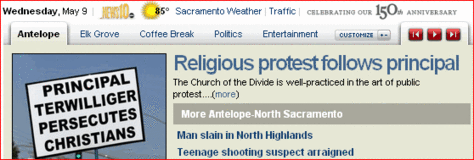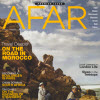ContentWise Blog
By Susan West & Michael Gold on June 13, 2007
The Online Publishers Association reports that video ads prompt Web users to act–even, in some cases, to buy.
A new OPA study ("Frames of Reference: Online Video Advertising, Content and Consumer Behavior") found that of the 80% of viewers who have watched a video ad online…
- 52% have taken some sort of action as a result
- 31% checked out a Web site
- 22% searched for more information
- 15% visited a store
- 12% made a purchase
For more details, see the OPA’s press release. The association is also offering free breakfast briefings to explore the study’s findings in depth at various U.S. cities throughout the month (registration required).
Posted in Advertising, Video
By Susan West & Michael Gold on June 11, 2007
We (editors) have all been there. The first draft of the article you assigned comes in off-target. It’s time for that critical tool of feedback, the rewrite letter—or, more likely, the rewrite e-mail—which outlines the revisions you want the writer to make.
Here’s a model rewrite letter (in the form of a PDF document) that we developed as the third ingredient in our recommended recipe for eliciting high-quality articles from freelance contributors. It’s based on the same basic themes that shape our model assignment letter and our other suggestions for getting the best from freelancers. In a nutshell: Be clear, be specific, and show that you value the writer’s knowledge and skills.
Follow this model and you’ll get a second draft that’s much closer to the bull’s-eye. Then you can edit and polish it into final shape.
Download PDF: The Rewrite Letter 
Posted in Magazines, Resources, Writing & Editing |
By Susan West & Michael Gold on May 23, 2007
Simon & Schuster is tapping into the wisdom of the crowd in an attempt to identify book ideas that could turn into blockbusters.
The company has partnered with newly launched Media Predict, an online "prediction market" modeled after similar systems that successfully forecast which candidates will win political elections and which movies will generate the highest box office receipts.
In essence, Media Predict is an online game in which traders use a limited number of virtual dollars to buy shares in book proposals that they believe will be successful. The proposals are submitted by literary agencies as well as individuals.
And who are these traders? Anyone with an interest in media who cares to register on the site.
Let’s all head over there, sign up as traders, and take this intriguing
tool for a test drive. It looks like a useful way to get first-hand
experience in the power of user participation–for anyone who publishes
anything on the Web.
Here’s how Simon & Schuster plans to use Media Predict. In October, it will choose one proposal from among those that are most highly valued by the "market." Touchstone, an S&S imprint, will then publish the book, assuming, as the company puts it, "the completed manuscript satisfies Touchstone’s publishing criteria."
In addition to books, Media Predict traders currently can bid on musical groups (will they get a record deal?) and television pilots (will the series get produced?). Eventually the site may expand into many more areas of media.
You’ll find a fuller explanation, including helpful videos, at How Media Predict Works.
Posted in Books, Social Media
By Susan West & Michael Gold on May 9, 2007
One of the handiest new wrinkles in Web design is the use of tabs to provide many different samplings of content within a compact area on a home page. The home pages of Yahoo and CNET, among many others, make good use of such tabbed promo boxes.
We just came across The Sacramento Bee’s clever wrinkle on this wrinkle.
 Sacbee.com enables users to assemble their own customized collection of tabs. Going beyond the usual suspects for categories (Top News, Politics, Sports…), the site offers tabs for many local regions (Antelope, Elk Grove, Yolo County…) as well as for topics off the beaten path (Coffee Break).
Sacbee.com enables users to assemble their own customized collection of tabs. Going beyond the usual suspects for categories (Top News, Politics, Sports…), the site offers tabs for many local regions (Antelope, Elk Grove, Yolo County…) as well as for topics off the beaten path (Coffee Break).
The site also lets users specify whether the promo box should rotate through the tabs automatically, and how fast.
In effect, Sacbee.com is giving each member of its audience an easy way to preview and access content within “channels” that interest him or her the most. That’s a personalization strategy that nearly every Web site could put to good use.
Way to be, Bee.
Posted in Design, Web Publishing
By Susan West & Michael Gold on May 2, 2007
The New York Times reports more bad news for major U.S. newspapers:
- a 2.1 percent drop in weekday circulation during the six-month period ending March 31, compared with the same time a
year earlier
- a 3.1 percent drop on
Sundays over the same period
But the online trend is encouraging, according to the Newspaper Association of America:
- More than 59 million people visited newspaper Web sites in the first quarter
of 2007, a 5.3 percent increase over
the same period a year ago.
- Visitors to newspaper sites generated nearly three billion
page views per month throughout the quarter, compared with 2.7
billion last year.
The association says the figures are the highest for any quarter since it began keeping track of newspaper Web sites in 2004.
Posted in Analytics, Measurement, & Trends, Multiplatform, Newspapers
By Susan West & Michael Gold on April 26, 2007
The Association of California School Administrators (one of our clients) needs someone to lead its expanding role online. This is a newly created, full-time position offering a competitive salary and generous benefits. The Web Director would be based at the association’s headquarters in Sacramento, California.
For more details, including information about how to apply, see the full job description.
Posted in Jobs & Opportunities
By Susan West & Michael Gold on April 24, 2007
The Stanford Professional Publishing Course is a nine-day extravaganza of skills-sharpening, state-of-the-industry briefings, strategy sessions, and networking for experienced pros in magazine and book publishing. It takes place on the University’s gorgeous, sun-drenched campus from July 13 to 21.
We would highly recommend it even if we weren’t on the faculty.
We’re offering one lucky reader of our blog a $1,000 scholarship to reduce the tuition from $4,350 to $3,350. Please send us an e-mail (<–by clicking on that link) saying that you’re interested. We’ll throw your name in the hat.
We must receive your e-mail by midnight (Pacific time) on Tuesday, May 1, which is the deadline for applying to the course.
We’ll announce our randomly chosen winner here soon after that.
By the way, even if you’ve already applied and been accepted to the course, you may use this scholarship to lower your cost.
For information on session topics, activities, and logistics, check the conference Web site and brochure (a PDF file).
Posted in Books, Conferences & Classes, Magazines
By Susan West & Michael Gold on April 4, 2007
We are helping one of our consulting clients recruit a Content Director for an interesting new health-oriented Web startup. This project is funded by the Silicon Valley venture capital powerhouses Kleiner Perkins and Sequoia Capital.
See the full job description (a PDF document). It includes information about how to apply.
If you are a candidate or you can recommend someone, we’d like to hear from you.
Posted in Jobs & Opportunities
By Susan West & Michael Gold on March 20, 2007
An intriguing new species in the world of online collaborative journalism has just been hatched. Assignment Zero is an experiment in “crowdsourcing”—that is, enlisting large groups of contributors to research and report on news and trends. Its organizers describe the project as “pro-am” because it relies on professional as well as citizen journalists.
Here’s how one of Assignment Zero’s founders, NYU journalism professor Jay Rosen, explains the idea:
“Can large groups of widely scattered people, working together voluntarily on the net, report on something happening in their world right now, and by dividing the work wisely tell the story more completely, while hitting high standards in truth, accuracy and free expression?”
Last summer Rosen proposed a similar project called NewAssignment.net (which we wrote about here). He also popularized the phrase “the people formerly known as the audience” to describe how Web site users are increasingly in the driver’s seat.
For editors and publishers who are trying to convince audiences to participate in their Web sites (and who isn’t?), it will be instructive to stay tuned as this project confronts such challenges as:
- How to organize and supervise an enthusiastic but possibly unruly crowd of amateurs in a virtual newsroom.
- How to coach an enthusiastic but possibly unskilled crowd of amateurs to create raw copy of reasonable quality.
- How to assess the credibility of these citizens.
- How to attract enough professional volunteers to turn the crowd’s contributions into coherent coverage. (And, incidentally, how to address the backlash from pros who don’t appreciate this push toward unpaid labor.)
In fact, Rosen issued a help-wanted call on his blog yesterday: It seems they’re getting plenty of “ams,” but they could use a lot more “pros.” If you’d like to watch the adventure of “open Web publishing” unfold from the front lines, here’s how to get involved.
Posted in User-Generated Content, Web Publishing |
By Susan West & Michael Gold on March 5, 2007
Why won’t that ridiculous urban legend about kidney kidnappers ever die?
There are several good reasons, all of them instructive for those of us who spend our days trying to craft engaging content and messages with staying power. You can learn the key to the kidney legend, and a bunch of other strategies for developing riveting ideas, in a useful new book: Made to Stick: Why Some Ideas Survive and Some Die.
Following their own advice, authors Chip and Dan Heath explore six basic principles of stickiness in an entertaining string of practical, surprising, authoritative, and, yes, memorable case studies, exercises, and guidelines. Some highlights:
- When searching for a powerful example, check the possibilities using the "Frank Sinatra test."
- Did you know that the "curse of knowledge" threatens to doom your
article, your headline, your presentation, the title of your book, the
organization of your Web site, and pretty much anything else you’re
trying to put across to an audience?
- Assignment: Using Bambi as your focus, develop an unforgettable message about the low risk of shark attacks.
(Visit the Made to Stick site for a generous excerpt, which includes the kidney caper.)
We’re putting Made to Stick on our bookshelf next to that other indispensable little guide about compelling communication by Strunk and White. We’ve nicknamed the Heath brothers’ new volume "The Elements of Stickiness."
Posted in Books, Marketing, Writing & Editing




